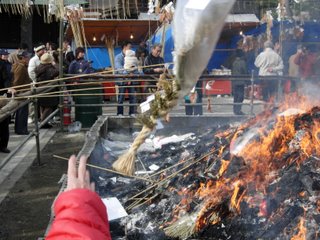




The photos were taken at Niigata City's most prominent shrine, Hakusan, on January 1st of this year. The Japanese regard the New Year as an opportunity to begin anew, to rededicate themselves to pursuits professional, educational, or commercial, and to invoke the gods' blessing on these, as well as on their friends and family. The passing of the old year and commencement of the new calls for a fresh slate on which to record the coming year's achievements. The Japanese bid farewell to the past year at end-of-the-year parties known as bo-nen kai, or the "forget-the-year gatherings." On New Year's Day, Japanese visit their shrine of choice to pray for health and good fortune, as well as to consign to the flames such objects as ema, shimekazari, wajime, daruma, and other mementoes of the preceding year. Now the ema is a small wooden plaque, approximately rectangular in shape and 3x5" in dimension. Ema can be purchased from most larger shrines, and bear on their upper surface the supplicant's handwritten prayer. The ema is then hung on a lattice frame or attached to a board near the entrance to the shrine's main hall. The shimekazari is the decorative form of the shimenawa and is hung above house doors at New Year's and, more commonly, the small family shrine, the shinzen or butsudan, kept in Japanese homes for the purpose of honoring one's ancestors. The wajime is a decorative straw wreath hung on the front doors of houses and some businesses, as well as the occasional automobile grille. The daruma is a pear-shaped red doll with one eye-socket blank, the other almost completely filled by its black pupil. Daruma are purchased by individuals or organizations at the start of an arduous campaign, whether political, athletic, or business-related. Should the endeavor prove successful, the doll's other eye is painted in out of gratitude. All of the above are placed on the pyre and replacements purchased. Not only is the fire a welcome source of warmth on a cold New Year's Day, but it is ideal for roasting surume-ika, or dried, salted cuttlefish, on the end of a ten-foot bamboo pole. Just why this delicacy is consumed at New Year's is a mystery to me, but certain it is that the local yakuza who operate the food stalls at this and other festivals profit handsomely from the sale of each 1000 yen ($8) "squid-on-a-stick." Another seasonal treat is roasted chestnuts, or kuri. According to no less an authority than Lafcadio Hearn, kachi-guri (as they are also known) are popular because the kachi of the name is homophonic with another kachi, that meaning "victory." What with monetary and other donations, as well as receipts from the sale of charms and related accessories, shrines such as Hakusan post a healthy profit at the end of the busy New Year's celebration.






No comments:
Post a Comment